[ESP-ENG] Tres instrumentos que deseo aprender a tocar // Three instruments I want to learn to play.
Since I was a child I grew up watching these great orchestras in their concerts, although I have not had the opportunity to attend many, I always watched them on television because I have been passionate about music in its different areas since I can remember. I developed this interest in a passionate way for three specific instruments, their melodies are really beautiful, almost indescribable, it is that melody that transmits peace and transports you to a different place than the one you are in at the moment. Now I will tell you a little more in detail about them:
Instrumentos

The Violin: My favorite instrument hands down, majestic, from its melody to its shape. A violin, therefore, resembles a viola, although it has a smaller size and emits a higher pitched sound. Who plays it is called a violinist. As for the bow used to play this instrument, it is a somewhat curved stick made of wood and a band made of horsehair. The violin is mainly used in classical music, although it can also appear in various folk, jazz, rock and pop music styles. Among the best-known violinists and composers for violin in history are Johann Sebastian Bach, Niccolò Paganini, Antonio Vivaldi and Giuseppe Tartini, among many others. In the old violins, the strings were made of gut. Today they can also be made of metal, silver or steel; the E string, the sharpest one (called cantino) is directly a steel wire, and, occasionally, of gold. Nowadays, strings are being made of synthetic materials that tend to combine the sonority achieved by the flexibility of the gut and the resistance of the metals. Violin music scores always use the treble clef, formerly called "violin clef".
Violin
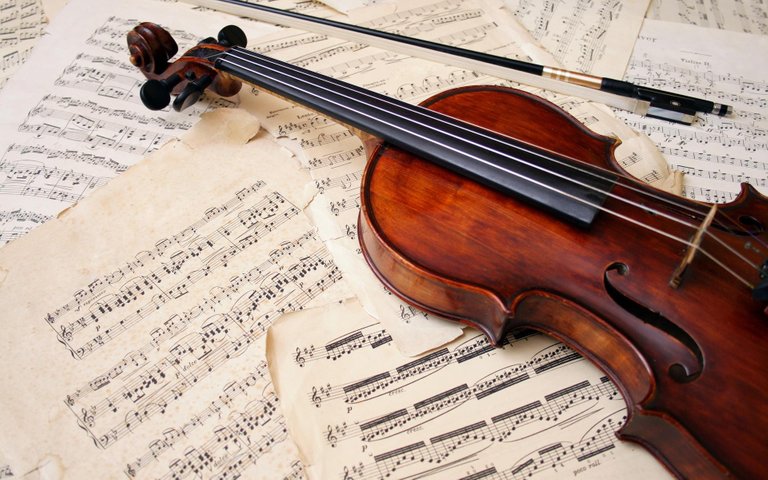
🎶Sol3
🎶Re4
🎶La4
🎶Mi5
The strings are tuned by intervals of fifths:
🎶Sol3
🎶Re4
🎶La4
🎶Mi5
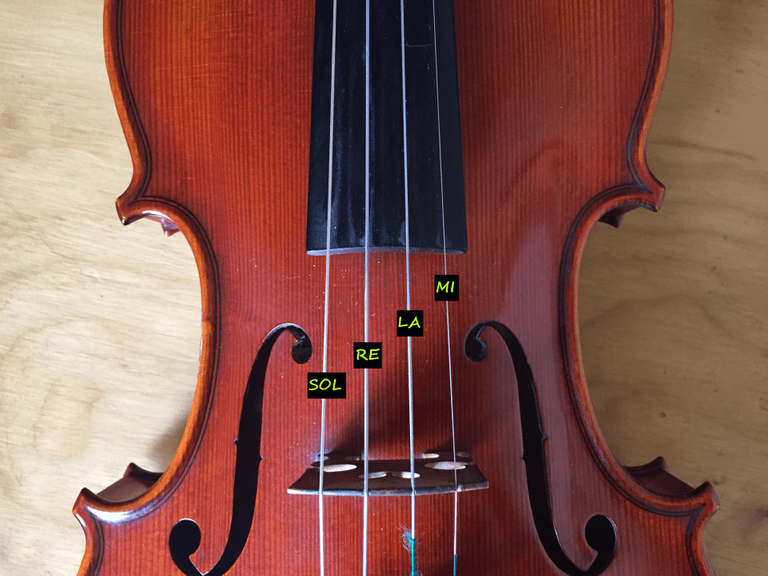
The way of holding the violin is a very important part in the teaching of the instrument in order to achieve a good playing technique. The first thing to take into account in the position of the violin is that it should be held in such a way that the eyes can be fixed on the head of the violin; and at the same time the left arm should be slightly forward so that the fingers are placed in a natural way and perpendicular to the fingerboard. In the same way, the correct and relaxed positioning of the instrument between the neck and the shoulder is important, both for the achievement of a good sound and performance and to protect the player from injuries due to unnecessary tensions. It should be placed as high as possible so that the left arm, hand and fingers are free to move and change position more easily.
Postura
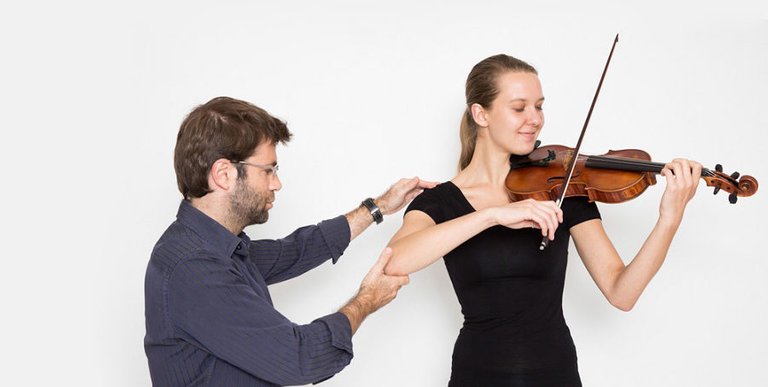
The Piano: The piano is a percussion instrument that consists of a soundboard with an integrated keyboard so that the steel strings can be percussed with felt-lined hammers to produce harmonic sounds. The piano is a majestic and portentous instrument with which you can create the most beautiful melodies that have been accompanying the art since medieval times. The current technological processes have made it possible for musicians or common people to play the instrument without owning it, this through the great diversity of piano games that abound on the web and that more than 50% have used at some time. This instrument has been widely used for music with voice accompaniment in choirs and melodies, as well as in the music of trios, quartets and even quintets or those that are duets. It has also been used with the accompaniment of some other instrument, such as the flute or violin.
Piano
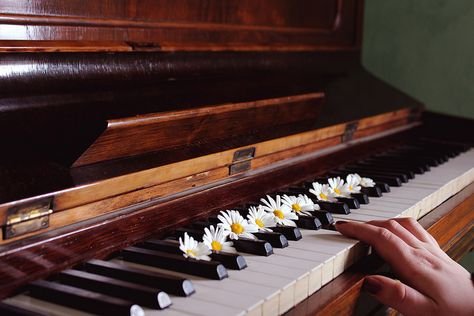
Types of piano They are divided into 3 types whose difference lies in how much space they occupy, these are grand, upright, digital or keyboard.
Grand Piano It is an instrument with a greater sonority, its design is elegant and with all its parts placed horizontally. Its size varies according to the manufacturer and type of tail instrument, it can be three-quarter tail (226 to 255 cm), one-quarter tail (131 to 189 cm), half tail (190 to 225 cm), mignon tail (130 cm) or grand tail, which are larger than 256 cm.
Piano de cola
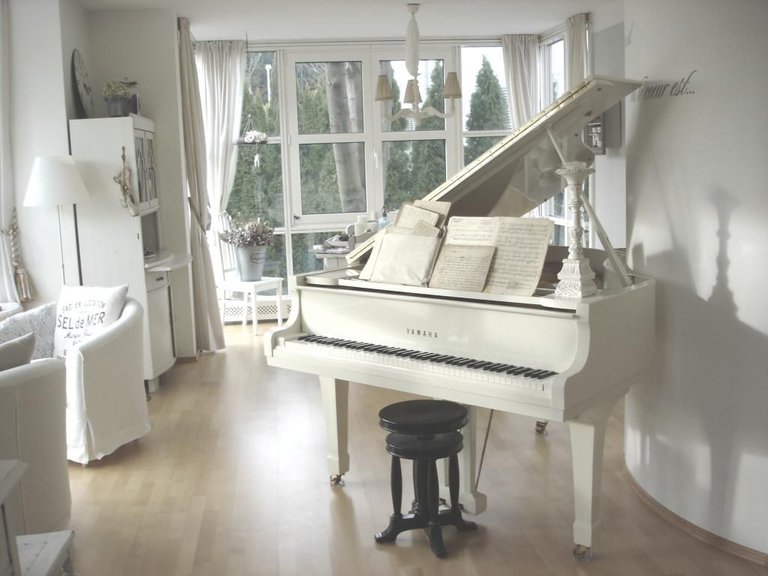
Upright Piano It is known as a wall instrument, it is simple, takes up less space and weighs about 150 kg. The piano notes are soft and special for composition. It is divided into four types, the first one is spinetta, the second one is console, the third one is studio and the last one is antique, which is characterized by having a great acoustic capacity.
Piano vertical
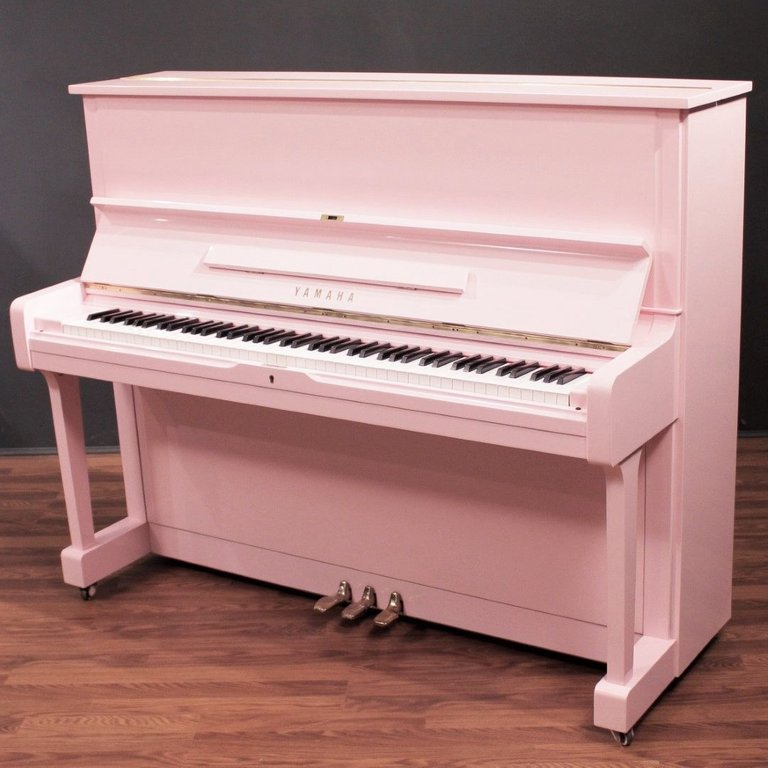
Electronic Piano: It was created in the 20th century and has the appearance of a conventional piano, but its difference lies in the fact that the sound is produced by electronic synthesis means, in addition to that, it can generate sounds of different instruments, incorporating rhythms and predetermined songs. These proportions are useful for playing piano chords with a single key, and can also be played in different styles. Another feature of this instrument is that the performer has the ability to save the songs he has played previously, so he can listen to them later and perfect the details of the practices.
Piano eléctrico
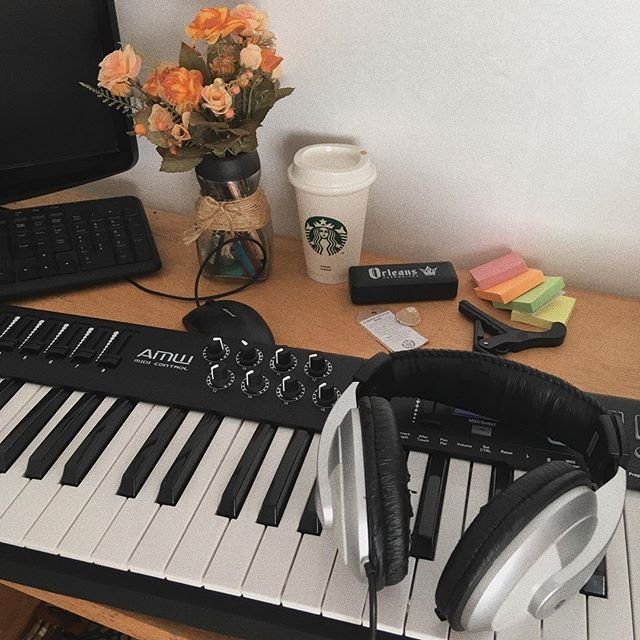
Ese instrumento se consideraba mágico ya que, entre otras cosas, le permitía controlar el orden de las estaciones y tenía la particularidad de que podía interpretar tres melodías: gentraiges (acorde de la risa), goltraiges (acorde del llanto) y suantraiges (acorde del sueño).
Las arpas se conocen desde la Antigüedad en Asia, África y Europa; se remontan al menos al año 3500 a. C. Se extendió llegando a las colonias de Europa, logrando una especial popularidad en América Latina.
The Harp: A harp is a musical instrument that has strings placed vertically and whose frame is shaped like a triangle. It is played with both hands, either with the fingers or with picks. The harp is used in classical music, thus being present in orchestras. The instrument has also been used in jazz, electronic music, rock and even pop, although less frequently. This instrument was considered magical because, among other things, it could control the order of the seasons and had the particularity of being able to play three melodies: gentraiges (chord of laughter), goltraiges (chord of crying) and suantraiges (chord of sleep). Harps have been known since Antiquity in Asia, Africa and Europe; they date back to at least 3500 B.C. They spread to the European colonies, achieving a special popularity in Latin America.
Arpa

✨Arpa celta: Se caracteriza por disponer de 34 cuerdas y un tamaño máximo de 105 centímetros.
✨Arpa paraguaya: Es una pieza clave de la música vernacular y que tiene la particularidad de que se afina de manera muy parecida a la de una guitarra.
✨Arpa venezolana: Fue difundida y adaptada en la región de los llanos venezolanos como arpa llanera o venezolana. A los llanos colombianos llega en 1960, por influencia de los arpistas apureños como Arturo Lamuño.
✨Arpa de boca: También llamada birimbao. Es un instrumento musical muy pequeño compuesto de un arco metálico y una lengüeta de acero. Se sostiene en la boca.
Some of the types of harps are the classical harp, currently used in orchestras, the Celtic harp, the Paraguayan harp, the Venezuelan harp and the mouth harp. The harp is a characteristic instrument in the traditional music of countries such as Ireland, Paraguay, Venezuela, Mexico, Germany, among others. It is necessary to establish that there are many and varied types of harps, among which we can highlight the following:
✨Celtic harp: It is characterized by having 34 strings and a maximum size of 105 centimeters.
Arpa Celta
✨Paraguayan harp: It is a key piece of vernacular music and has the particularity that it is tuned in a very similar way to that of a guitar.
Arpa Paraguaya
✨Venezuelan harp: It was spread and adapted in the region of the Venezuelan plains as "llanera" or "venezolana" harp. It arrived in the Colombian plains in 1960, under the influence of harpists from Apure, such as Arturo Lamuño.
Arpa Llanera
✨Mouth harp: Also called birimbao. It is a very small musical instrument composed of a metallic bow and a steel reed. It is held in the mouth.
Arpa de boca
¡Muchas gracias por leerme, espero les haya gustado! Nos vemos en el próximo post.Thank you very much for reading me, i hope you liked it! See you in the next post.Fuentes bibliográficas:
🎶El violin: https://es.wikipedia.org/wiki/Viol%C3%ADn
🎶EL piano: https://es.wikipedia.org/wiki/Piano
🎶EL arpa: http://www.melomanos.com/la-musica/instrumentos-musicales/cordofonos/arpa/📸Imagen gratis del violin: http://fon.at.ua/photo/kartinki_muzyka/skripka_lezhit_na_notnykh_listakh/24-0-1352
📸Postura del violin: https://paketaninternet.com/gallery/c%C3%B3mo-escoger-un-viol%C3%ADn-deviolines.html
📸Foto gratis del piano: https://www.catorze.cat/el-piano/somni-amor-franz-liszt-3-90404/
📸Piano de cola: https://www.wattpad.com/amp/898670839
📸Piano vertical: https://carusopianos.com/index.php?virtuemart_manufacturer_id[0]=4&virtuemart_manufacturer_id[4]=8&virtuemart_manufacturer_id[7]=1&custom_f_10[0]=496e2053686f77726f6f6d&custom_f_10[1]=576169746c697374&custom_f_51[0]=506572666f726d616e6365&Itemid=615&option=com_customfilters&view=products
📸Piano eléctrico: https://www.pinterest.com/SallyAdrianaM/music/
Imagen gratis del arpa: https://www.pinterest.com.mx/pin/687502699353536716/
📸Arpa celta: https://www.pinterest.es/pin/727049933572376398/
📸Arpa paraguaya: https://www.ultimahora.com/ejecucion-y-fabricacion-del-arpa-son-declaradas-patrimonio-cultural-inmaterial-n2843914.html
📸Arpa llanera: https://horadelrecreo.com/c-instrumentos-musicales/arpa-llanera/
📸Arpa de boca: http://eriamusicacuarto.blogspot.com/2017/03/
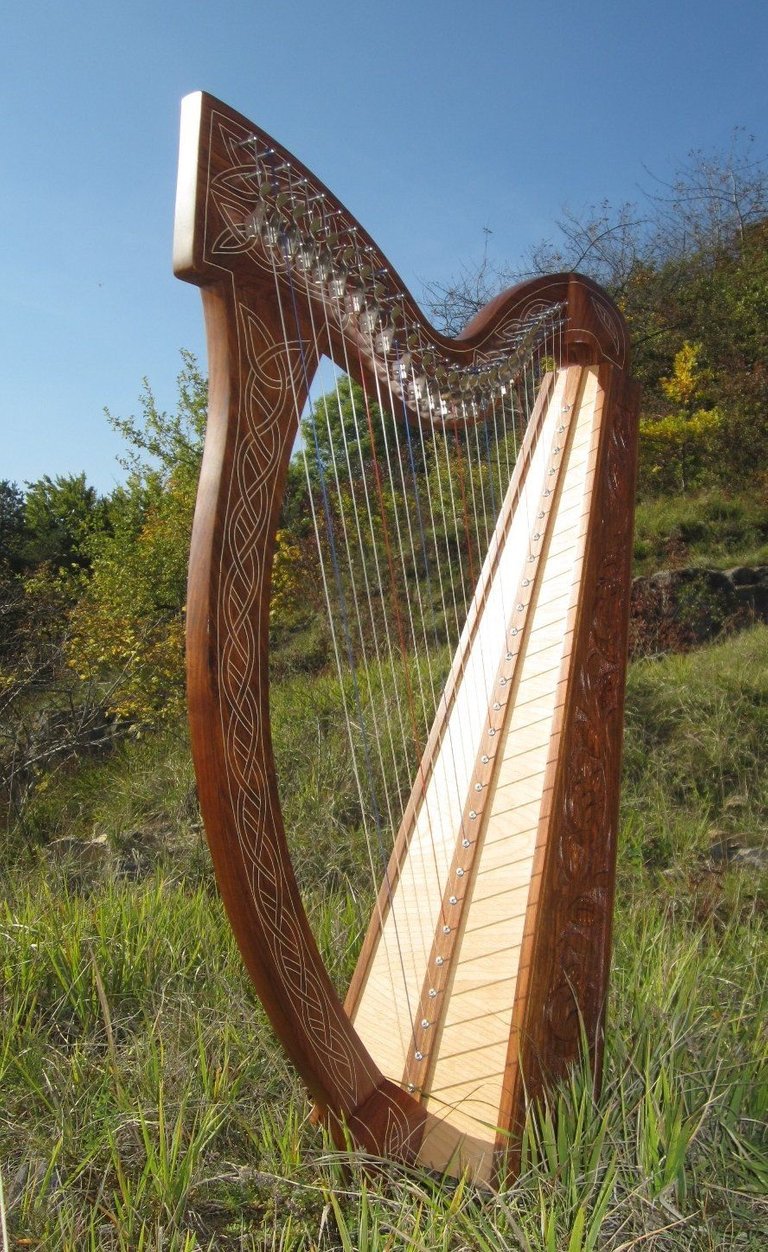
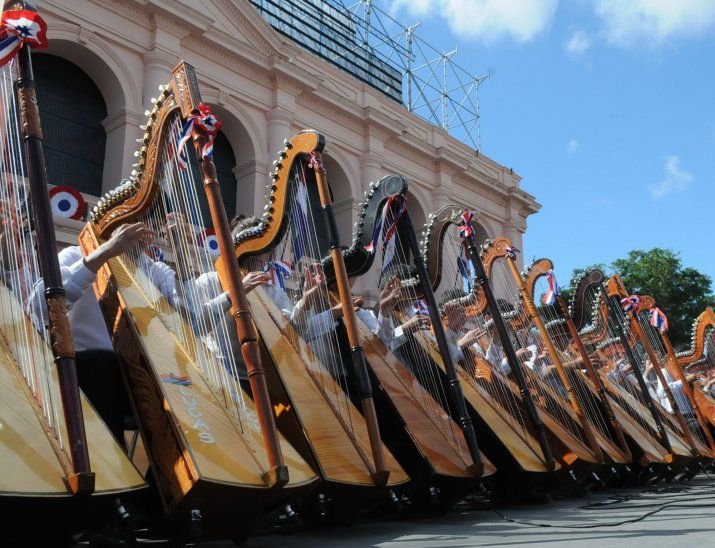
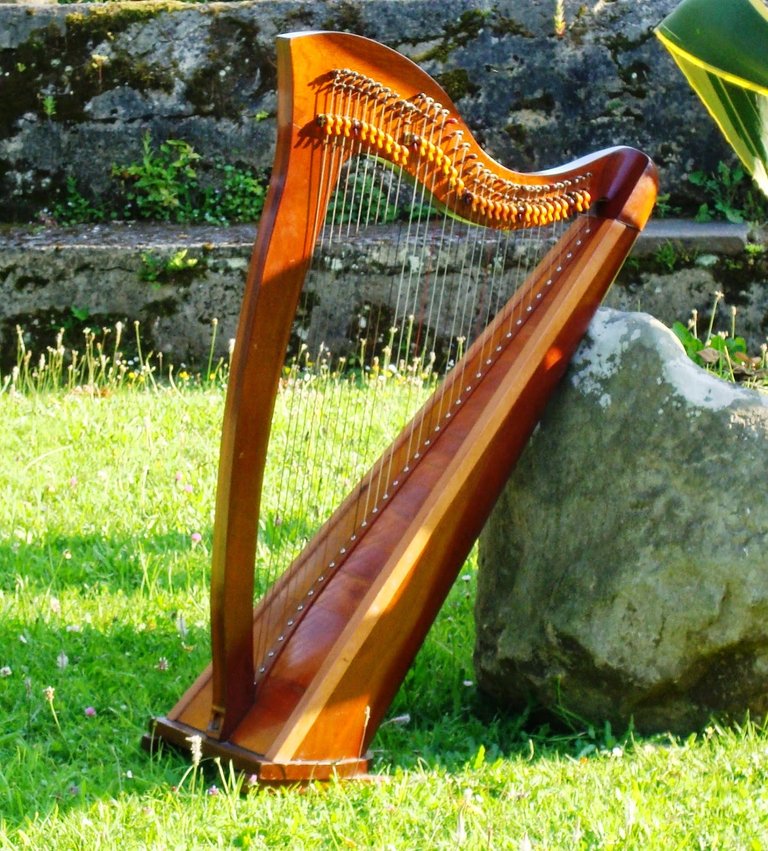
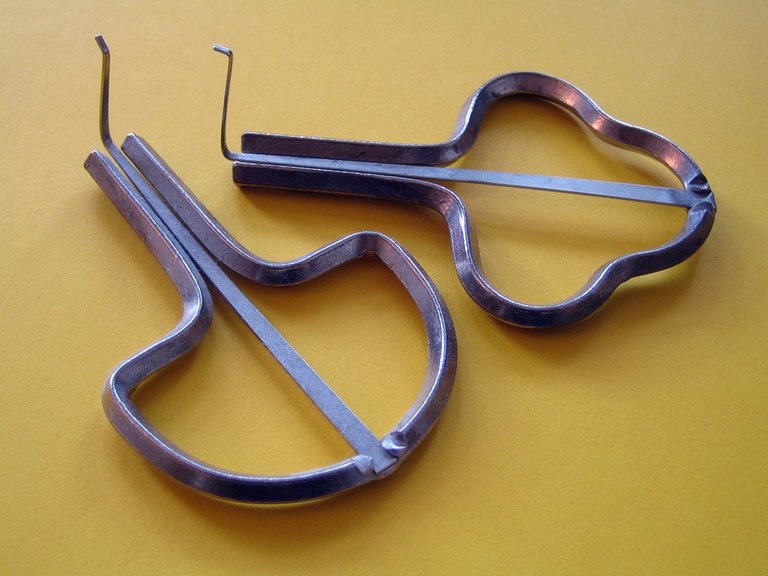
Hola @mariam3 muy buen post, te felicito e igualmente ojala tuvieras la oportunidad de estudiar y aprender por lo menos algunos de los 3 instrumentos si te gustan mucho y si el escuchar la melodía de estos son muy relajantes, estas generan una ambiente de armonía y nos transportan a tener paz continúa con tu buen post sigue así y espero poderte leer en próximas oportunidades, Saludos
Muchísimas gracias, comentarios como el de usted me motivan a seguir acá, feliz día♥
Muchísimas gracias por su apoyo♥
As a member of the terminal we help and guide , so let me ask you did you read this comment ?
First, please see my previous comment from your post about images from social media such as Pinterest.
Next, did you check all the sites (including Wikipedia) in this post where you indicate you took the images from to see if the images are free to use? If not, then find other images that are free.
Then, if the images are free, you need to link directly to them. Just providing the website page is not linking directly to the image.
https://es.wikipedia.org/wiki/Piano
Where on this page is a photo of the piano? You need to first click on the image to find out if the image is free to use, then locate the direct link in the address bar. Please do this for each image
@mariam3 It would be much easier for your readers if you placed the source of the image directly under each one.
And did you get the message?
Hi, I don't know how to place them under each image, that's why I put them at the end. And yes, a few days ago I realized that they were free, even there are the links, the post has already been edited a few times.
Well keep editing til you are sure you won’t run in to trouble. You just started if you get caught for plagiarism than you can be sure your rep and hive is so low it’s a big way back , just my two cents and warning
What if Pixabay (a free photo site recommended to me) does not have the images I need? How do I do in that case? I have already tried several times and I can't find what I'm looking for.
Well in pixabay try another word for the topic you need and there are other sites did you see the terminal? Rooms for information, come there interact and we will help you
Thank you very much, I'll be right there, I'm working.♥
Me encanta tu pasión, se que lograrás todo lo que te propongas!! Saludos, te invito a pasar por mi blog🥺❤️
Me ha encantado tu publicación, está llena de información resumida pero directa de manera que aquellos como yo que no tenemos mayor conocimiento podamos estar claro de estos tres instrumentos.
Me encanta el sonido del violín, el arpa es como hechizos al oído pero el piano, ese instrumento tiene fuerza, magia, elegancia, me fascina.
Gracias por compartir.
Felicidades.
Muchísimas gracias por su lindo comentario, y si, el piano es realmente mágico y perfección en toda su palabra!
Hello @mariam3 I can feel your love for music and the three instruments you highlight in your article. What a nice summary of each instrument. I'd love to learn how to play the harp.
I'd like to ask where you obtained your images of the instruments from that you used in your post? Are they from a site with free photos you use?
Also you include in your post information about the origins of the instruments. I don't see where you include the link to the site where you found the information.
Corrected, thanks again for your comment and I will keep it in mind for future posts, greetings!
Hello @mariam3 I see you edited your post to include sourcing for the various instruments. However, there are still issues.
First, please see my previous comment from your post about images from social media such as Pinterest.
Next, did you check all the sites (including Wikipedia) in this post where you indicate you took the images from to see if the images are free to use? If not, then find other images that are free.
Then, if the images are free, you need to link directly to them. Just providing the website page is not linking directly to the image.
https://es.wikipedia.org/wiki/Piano
Where on this page is a photo of the piano? You need to first click on the image to find out if the image is free to use, then locate the direct link in the address bar. Please do this for each image
@mariam3 It would be much easier for your readers if you placed the source of the image directly under each one.
Es un gusto, me encantó tu post, muy bien explicado, mi instrumento favorito también es el teclado, no lo sé tocar pero nunca es tarde para hacerlo, por ahorita me defiendo un poco con la guitarra aún sigo en práctica jeje pero muero por un teclado, un gusto colega soy cantante y se lo que se siente cuando suena esos hermosos instrumentos. Un abrazo ❤️👌😎
Te deseo el mejor de los éxitos y si, también deseo un pero un piano de cola, aaaa son tan hermosos:c
Que lindo todo, te deseo lo máximo para que logres aprender sobre ellos, en lo personal me gustaría el piano y el bajo je, je <3
Animo! Puedes hacerlo!!
Aún no pierdo las esperanzas, gracias!♥
I would love to be able to play the violin and harp. When I was young, I had music lessons with a few friends, but they wanted to play the flute. I followed them, but should have gone for the violin!
Same, it has always been my dream and I hope to achieve it someday, I'm still young I guess.♥
Wow ❤️
Such a lovely post
The harp is a really beautiful musical instrument. It attracts me.